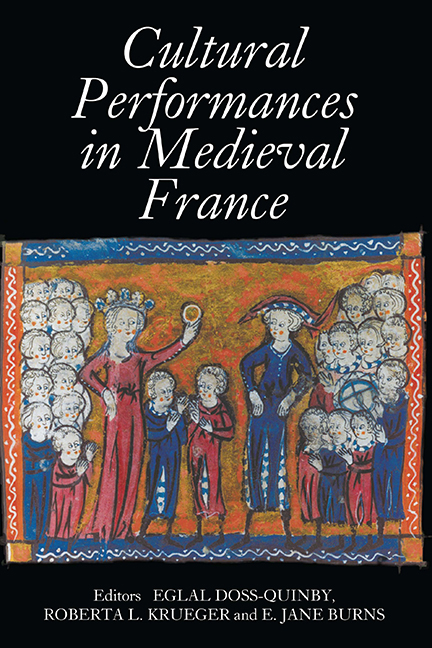Book contents
- Frontmatter
- Contents
- List of Illustrations
- Contributors
- Introduction
- Nancy Freeman Regalado, Curriculum Vitae
- PART I POETIC AND MUSICAL PERFORMANCES
- PART II PERFORMING SEXUAL AND SOCIAL IDENTITIES
- Intimate Performance: An Ivory Writing Tablet Cover at The Cloisters
- A Cultural Performance in Silk: Sebelinne's aumousniere in the Dit de l'Empereur Constant
- Acting Like a Man: Performing Gender in Tristan de Nanteuil
- Amorous Performances: The Aventure de l'espee vermeille in Perceforest
- Historicizing Performance: The Case of the Jeu de Robin et Marion
- The Protean Performer: Defining Minstrel Identity in Tristan Narratives
- PART III DEVOTIONAL PRACTICE AND TEXTUAL PERFORMANCE
- PART IV PERSUASIVE PERFORMANCES
- PART V RE–ENACTMENTS AND LEGACIES
- Tabula Gratulatoria
- Tabula Gratulatoria
Historicizing Performance: The Case of the Jeu de Robin et Marion
from PART II - PERFORMING SEXUAL AND SOCIAL IDENTITIES
Published online by Cambridge University Press: 24 October 2017
- Frontmatter
- Contents
- List of Illustrations
- Contributors
- Introduction
- Nancy Freeman Regalado, Curriculum Vitae
- PART I POETIC AND MUSICAL PERFORMANCES
- PART II PERFORMING SEXUAL AND SOCIAL IDENTITIES
- Intimate Performance: An Ivory Writing Tablet Cover at The Cloisters
- A Cultural Performance in Silk: Sebelinne's aumousniere in the Dit de l'Empereur Constant
- Acting Like a Man: Performing Gender in Tristan de Nanteuil
- Amorous Performances: The Aventure de l'espee vermeille in Perceforest
- Historicizing Performance: The Case of the Jeu de Robin et Marion
- The Protean Performer: Defining Minstrel Identity in Tristan Narratives
- PART III DEVOTIONAL PRACTICE AND TEXTUAL PERFORMANCE
- PART IV PERSUASIVE PERFORMANCES
- PART V RE–ENACTMENTS AND LEGACIES
- Tabula Gratulatoria
- Tabula Gratulatoria
Summary
Adam de la Halle's Jeu de Robin et Marion is a work that raises issues of performance in both unsubtle and subtle ways. It has gained archetypal status by being not only a rare example of pre-1300 vernacular and secular “theater,” but also apparently the only dramatized version of pastourelle and bergerie in the period. Less obviously, it stands out from the bulk of Adam's works by having a possible connection with the Angevin court at Naples, a connection that has seemed hard to make with the rest of his more directly urban, Arrageois work. The courtly context of Naples poses a conundrum that might be felt to apply more broadly to our interpretation of medieval drama. For on the one hand it temptingly provides a historicizable context for performance, and thereby a means of locating the jeu quite precisely within a certain social and cultural nexus. Yet on the other, Robin et Marion draws so directly on a highly characterizable genre that it resists such specification. It encourages us, by contrast, to think of its qualities as a work in performance in more abstract terms, ones that are posited and defined more by transhistorical generic expectations than by the singular immediacy of a particular occasion and audience. This creates stark differences in the interpretative history of the work. What does it mean to be Angevin in Naples in the thirteenth century? I will try to connect this question to certain features of Adam's Jeu in performance. The attempt represents a case study in the complexities of historicizing performance.
As is well known, Adam's connection to Naples was brought about by Robert II, Count of Artois. Against the background of impending social disorder created by the Sicilian uprising in 1282, Charles, the Angevin ruler, sought literary and musical as well as martial and financial aid from his two nephews, Robert d'Artois and Pierre d'Alençon. Poets and musicians were brought over from France, including many from the Arras region such as Perrin d'Angicourt, Rutebeuf, Raoul de Soissons, and Adam de la Halle himself, specifically to provide a highly visible cultural profile for the displaced and newly vulnerable court. This initiative is worth further investigation on both political and literary grounds: although these poets have been individually studied, much work remains to be done on their cumulative role in defining a contemporary image of Angevin rule.
- Type
- Chapter
- Information
- Cultural Performances in Medieval FranceEssays in Honor of Nancy Freeman Regalado, pp. 99 - 108Publisher: Boydell & BrewerPrint publication year: 2007



